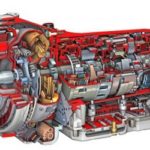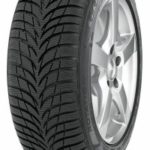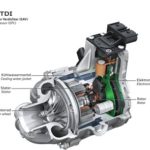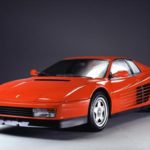Differential, more precisely 'differential transmission'
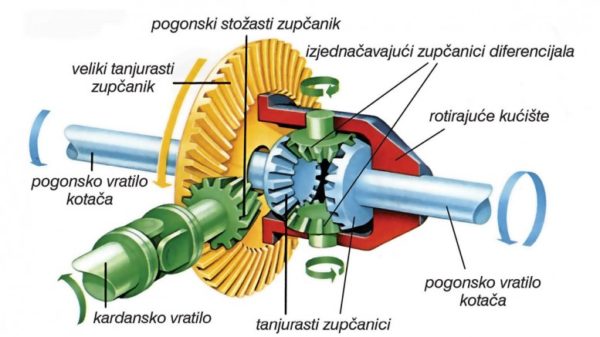
Differential
An assembly of planetary, disc and bevel gears that allows driving in a curve
Everyone knows that it is installed in a car, and yet, there are few who know what it is about, what it is used for and how it works. The differential, or differential transmission, is used in almost all vehicles with four or more wheels. The exception is new vehicles - four-wheeled motorcycles (Quad), which may or may not have a differential. The basic function is to ensure driving on curves, without slipping, when the inner wheel crosses a shorter path than the outer one. Therefore, it is necessary to differentiate (make different) the speeds of the drive wheels, so that the outer wheel rotates faster, and the inner one slower.
This is achieved by a planetary assembly with two opposite conical sun (central) gears coupled to half shafts and two tapered planetary gears coupled to the sun gears. What we call a differential, broadly speaking, consists of a hypoid gear set and a differential gear unit. The planetary gears rotate on an axle secured to the differential housing, connected to the gearbox, reduction ratio 3: 1 to 6: 1. Its primary function is to bring power to the differential, and its secondary reduction is the speed of rotation.
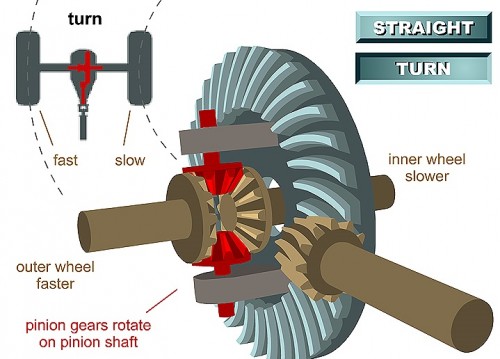
The differential gear divides the power into the rear wheels, so that they can rotate at different speeds along curved paths at different speeds without slipping.
In rear-wheel drive cars, where power is transmitted vertically to the rear wheels (90 °), the housing is mounted on a disc gear, driven by a bevel gear connected to the PTO shaft. Bevel gears can be ordinary or hypoid, in which the axis of the drive bevel gear is lower than the axis of the plate (they are out of direction). In front-wheel drive cars, the differential housing is powered by a cylindrical bevel gear, which generates less loss but is slightly noisier than the rear-wheel drive hypoid transmission. This is one of the reasons why cars with a transversely mounted engine and front-wheel drive create the least resistance.
As part of the differential, a final reducer is installed, depending on the type of engine and the purpose of the vehicle. The disadvantage of the differential is that the power always goes along the line of least resistance, and if one wheel starts to slip, the other completely loses driving power. Therefore, differential locks are installed, which can be performed in two ways: by using solar and planetary gears with hypoid gearing of increased friction or viscous clutch-brakes on each half-shaft. In the first case, it is a self-locking differential of the Torsen type), and in the second it is an electronically controlled viscous differential lock.
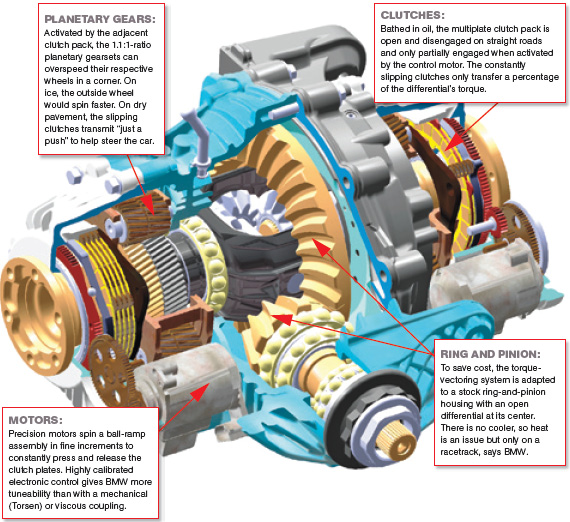
A mechanical or electronic lock is installed to prevent the differential from being more harmful than useful when driving sharply, due to the unloading wheel slipping (on the inside of the curve).
The best combination is electronic and mechanical blocking, which is expressed as a percentage of the power that is directed to the wheel in the grip with the ground (otherwise it would be lost). The next step was made by the Vector-Drive differential, which enables independent transmission of more or less torque (and power) to the inner or outer wheel. This gives the required rotation impulse in both directions and improves stability and handling. It works on the principle of planetary gears and electromagnetic couplings, and everything is controlled by electronics, which record the kim sensor system…
… All important driving parameters (primarily rotation speed around the vertical axis and lateral acceleration). When the electronics recognize understeer at the beginning of the maneuver, it sends an additional impulse of power to the outer wheel and the car steers faster in corners. When the rear of the car starts to drift abruptly (oversteer, which leads to a dynamically unstable situation), the power at the inner wheel increases and the car stabilizes. This is especially important for rear-wheel drive cars, which are more unstable than those with front-wheel drive, so the differential with power vectoring allows cornering speed as with 4 × 4 all-wheel drive.
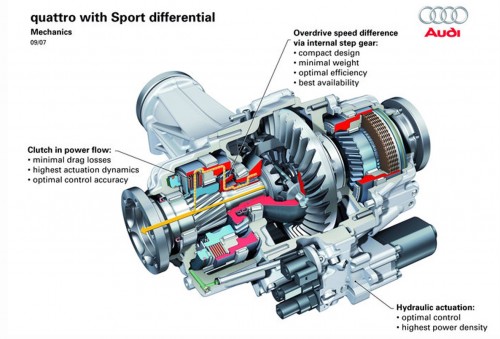
Vectoring, that is, directing power to a better grip wheel unites the benefits of differential locking and ESP system, except that the action is by accelerating instead of braking, on the opposite side
Source: autoportal.hr
Recommendation of similar texts:

Hi there, I am Mladen and I am an auto enthusiast. I started this blog years ago to help like minded people share information about latest cars, car servicing ideas, used car info, exotic cars, and auto technology. You will find helpful articles and videos on a wide variety of cars - Audi, Mercedes, Toyota, Porsche, Volvo, BMW and much more. Ping us if you have anything cool to share on latest cars or on how to make older cars more efficient, or just want to say hi!

